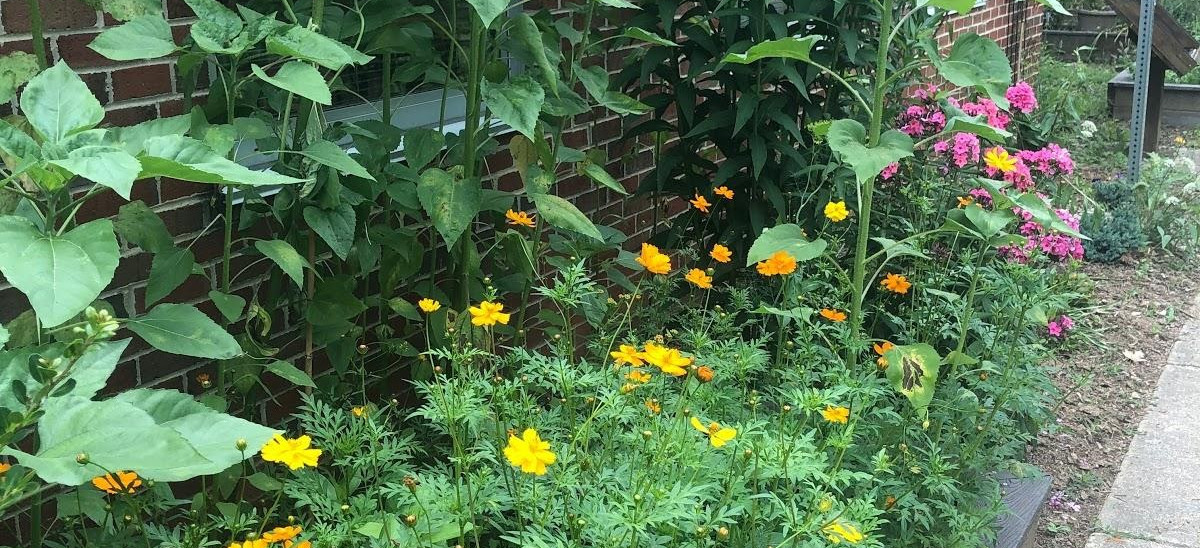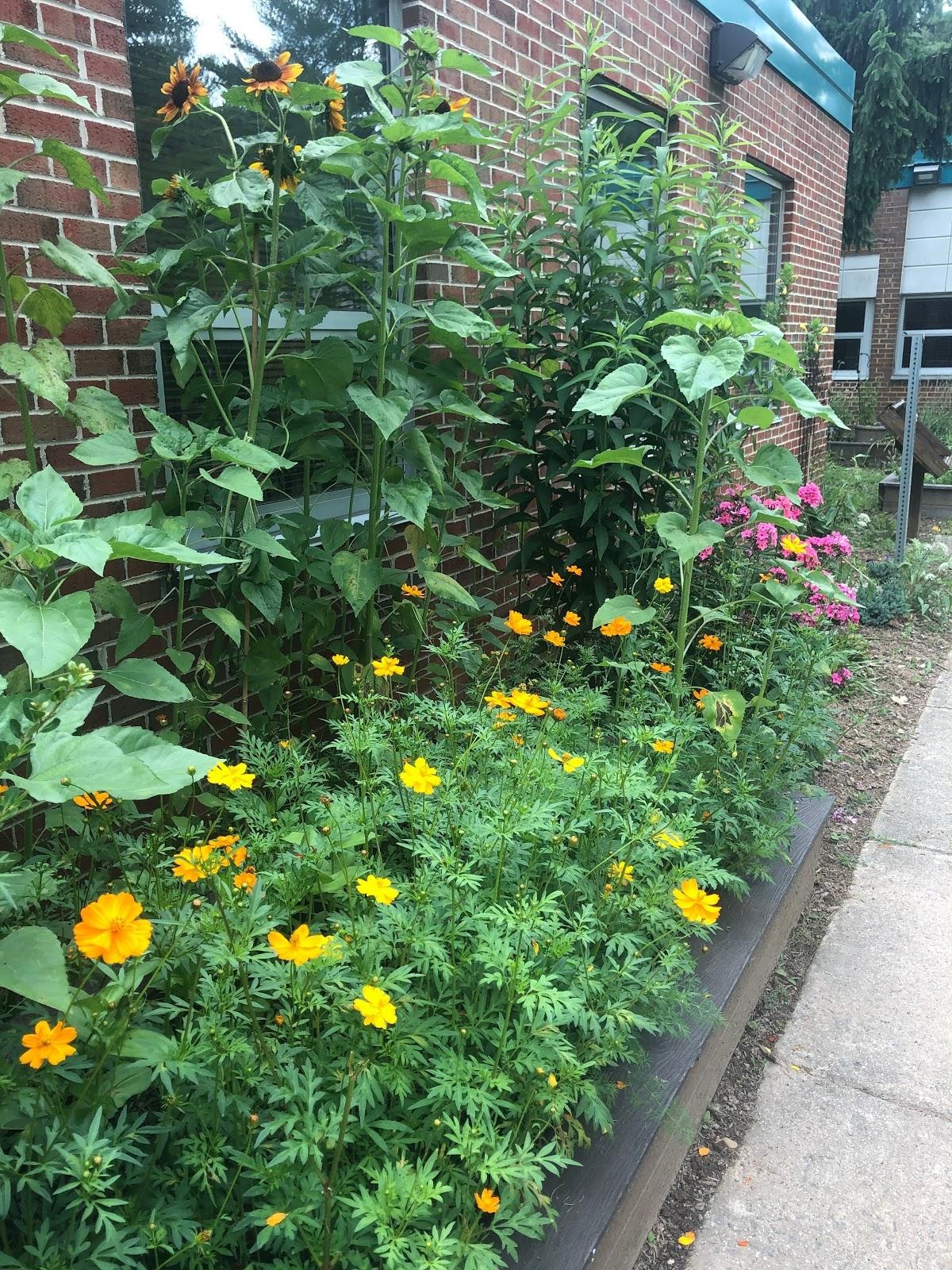The Importance of School Gardens During the Pandemic
Winter is a fallow time in the garden, a time of rest for plants and soil before another active growing season begins. For gardeners it is a time of planning and anticipation. For those who work in school gardens it is a time of preparing students for the joys and wonders, observations and discoveries to be encountered in the seasons ahead. Whether it is starting seeds indoors, turning compost, observing birds and pollinators, searching for the turtles to see if they have come out of hibernation or preparing a new garden bed, this time is usually busy and filled with excitement on the part of teachers and students of all ages. However, for most school gardens in 2020, the fallow time extended far beyond last winter as well as beyond last year’s growing season.
Just prior to schools being closed due to the pandemic, first graders had started tomato and pepper plants indoors. Peas and carrots had been sown outdoors by sixth graders and lettuce, kale, and spinach were already being harvested for our school salad bar. Kindergarteners had made their first observations of the tulip bulbs they had planted in the fall as part of the Journey North project. The abrupt closure left school gardens like ours in a precarious state. It would have been easy to let it all go to seed as they say. Without knowing when the return to school would come, I collected the vegetable starts and seed packets, tools and supplies and brought them home. Too much had already been invested in that year’s growing season.
Our school is fortunate to have a robust outdoor education and gardening program with many gardens, including vegetable, tulip, pollinator and native plant gardens located along the perimeter of the school. As spring began to unfold, I was able to come by and check on the status of the gardens and keep our anxious students apprised of the condition and changes that were occurring in the beautiful spaces they had helped create and care for. A mailbox was erected near the vegetable garden thanks to a supportive co-worker and the seeds that students had gathered the previous fall were packaged and left for pick up. The seed pick up proved to be popular as students and parents made frequent rendezvous to see what was growing in the garden along with getting a packet or two of seeds to try at home. It also proved to be an important way to stay physically connected to school.
At about the same time, the seed starts were ready to be transplanted. They were planted in the raised beds along with cucumbers, squash and beans. It was not uncommon during these days to have residents from the surrounding neighborhood stop by in a socially distanced manner and ask about the gardens. It became an excellent opportunity to do a little PR and inform them of the way we use our outdoor learning spaces and how important they are to our students. Many people were surprised and impressed to hear how outdoor and environmental learning had been incorporated into students’ days.
One may well wonder what was becoming of the vegetables that were ripening along with what was happening in other parts of the garden. As spring segued into summer, students continued to occasionally stop by and were invited to harvest from the garden. Some produce was harvested for the local food pantry and as always, the gardens continued to be used as teaching resources. As most students had not been able to come to the gardens, I brought the gardens to them. I documented what was happening through photos and videos, offering lessons on seed gathering, pollinators, composting, harvesting and preserving; anything to help them stay connected to the beautiful spaces they love.
Despite COVID, the gardens burst into their full beauty during late summer and into fall. Monarchs returned, laid their eggs and formed their chrysalides. Numerous other pollinators darted amongst the riot of zinnias and cosmos that germinated from the seeds that had fallen the previous fall. The natural world continued with its magnificent display of wonders to be observed and delighted in. I continued to visit the gardens on a regular basis in anticipation of our students’ return. It was important that they return to beloved spaces that remained cared for and ready for outdoor learning to continue. What I hadn’t anticipated were the many people, who joined me at an acceptable social distance as they came to walk, ride bikes and skate by. They were members of our school family but also residents of the surrounding community who had no personal connection to the school. I was humbled by their comments on how much they appreciated the gardens for the beauty and solace they provided and how it had helped them cope with some of the challenges that COVID had brought into their lives.
Surprises continued. While keeping up with the harvesting, a request came in from an Eagle Scout candidate to do her required community service project in our gardens. Such a request is not uncommon under normal circumstances but COVID presented additional challenges including choosing an accessible site and working to complete the project before winter. With a great deal of perseverance, community support and attention to COVID precautions one of the first female candidates for the rank of Eagle Scout and a former student from our school, designed and installed a book themed garden. This latest addition to our pollinator gardens based on Eric Carle’s book, The Very Hungry Caterpillar will be waiting to greet our students upon their return to school. The opportunities provided by our gardens clearly had hardly disappeared.
As we plan a return to school it dawns on me that one could hardly be faulted for not wondering about the fate of gardens during our extended absence from school grounds especially given the challenges that a prolonged period of virtual learning has presented. Many areas that had been carefully tended and cultivated to provide meaningful outdoor experiences for our students have suffered from unintentional neglect and will require much effort to restore them to their former usefulness. The pandemic has demonstrated that there can be no doubt of the value of these spaces to the health and well-being of all members of our community. They are worthy of the time, effort and resources it will take to restore and care for them. The gardens are ready to be filled with the gleeful shouts and enthusiastic curiosity of our students upon their return. I know our students are eagerly anticipating reconnecting with those cherished places as another growing season begins.



